Warty Squid
A new species joins the ranks
Talking about squids without talking about taxonomy (the study of the classification of organisms) is impossible on this ship. Our resident expert is Dr Heather Braid, a squid taxonomist and conservation geneticist. And thus I bring you: the warty squid, a large helping of taxonomic information, and a new discovery.
Right: MRQ big-wart warty squid
Is the warty squid just one species? Of course not. That would be far too simple.
There are two types found in New Zealand waters, one with big knobbly warts and one with teeny tiny ones. When collecting data in the wet lab on Tangaroa, we use the code MRQ for the big-wart warty squid, and the code MIQ for the little-wart warty squid.

Above: MIQ little-wart warty squid (left) and MRQ big-wart warty squid
So far, so good. Everything makes sense. But within these two types there are several different species, many of which are undescribed (as mentioned in the ghost shark creature feature, this means that we know they exist, but they haven’t been officially recognised and described in a scientific paper).
And for the MIQ little-wart squid, there are not only undescribed species, but a completely new species that was found on a Chatham Rise survey. The two specimens available from this species are babies, which, as Heather says, “are cute but a bit useless for taxonomy.” However, on the Sub-Antarctic survey we are conducting right now, we found an adult squid which may be a part of this new species! It is an MIQ little-wart squid with fins a lot smaller than you would expect from a normal little-wart squid. Fin size is militantly uniform in MIQ squids, so this seemingly insignificant difference is extremely promising.
If genetic tests prove it to be an individual of the new species, it may have the honour of becoming the new species’ holotype. This is the chosen one, the perfect specimen which future researchers can look at and say, “Ah yes, that is what she meant by this description.” Describing features such as tentacle shape and the number of hooks is extremely useful, but nothing beats having a picture of the squid in question right before your eyes.
And speaking of squids right before your eyes, next up we have possibly the cutest of them all: the bobtail squid.


